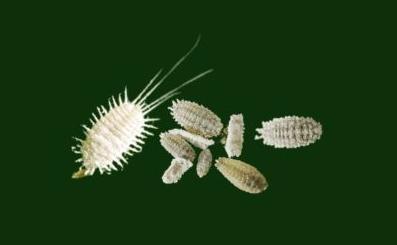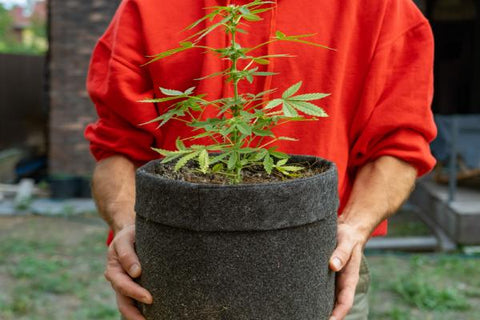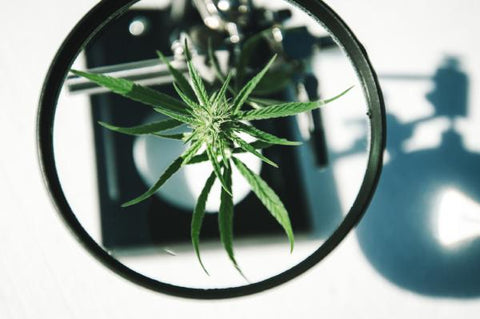
Tabla de contenidos
[HideShow]
- Step-by-step guide to eliminating mealybugs in cannabis cultivation
- 1. Step 1: Identifying Mealybug Infestation
- 2. Step 2: Isolation of Plants Affected by Mealybug
- 3. Step 3: Manual Removal
- 4. Step 4: Cleaning and Disinfection in the Management of Cottony Cushion Scale
- 5. Step 5: Using Insecticides for Cottony Cushion Scale Treatment
- 6. Step 6: Long-Term Prevention and Control of Mealybugs
- 7. Step 7: Assessment and Adjustments in Mealybug Management
- Home Remedies to Eliminate Cottony Cushion Scale
- 1. Homemade Insecticidal Soap
- 2. Isopropyl Alcohol
- 3. Garlic or Hot Pepper Infusion
- Leave a comment
How to get rid of mealybugs?
The cottony cushion scale, a persistent adversary in the world of horticulture, has become a notable concern for cannabis growers. This small but formidable insect, recognizable by its distinctive waxy, cotton-like covering, feeds on the sap of plants, severely weakening them. In cannabis crops, the presence of the cottony cushion scale not only diminishes the vitality of the plants, but can also compromise the quality and quantity of the harvest. By sucking out essential nutrients, this parasite leaves plants vulnerable to disease and general deterioration.
The importance of knowing how to eliminate mealybugs and prevent their appearance cannot be underestimated. Effective control of this pest is crucial to maintaining the health and productivity of cannabis crops. Proper and timely treatment can mean the difference between a successful harvest and one affected by quality and yield issues. Furthermore, understanding prevention and elimination methods not only helps combat existing infestations, but also minimizes the risk of future outbreaks, thus ensuring a more robust and resilient crop.

Step-by-step guide to eliminating mealybugs in cannabis cultivation
Eliminating mealybugs involves a combination of accurate identification, containment measures, organic treatments, and in severe cases, the use of insecticides. Each step in this process is crucial to ensure the infestation is effectively managed and to prevent future outbreaks. In this guide, we will provide a step-by-step approach to tackling this pest, from initial identification to long-term prevention strategies, ensuring your cannabis crop remains healthy and mealybug-free.
Step 1: Identifying Mealybug Infestation
- Look for Visible Signs : Educate yourself and understand why mealybugs appear . Carefully inspect your cannabis plants for cottony spots or masses that indicate the presence of mealybugs, commonly located on stems, leaves and buds.
- Honeydew Watch : Look for signs of honeydew, a sticky, sweet substance excreted by mealybugs, which can lead to the development of black sooty mold.
- Mark Infested Plants and Areas : Use labels or markers to identify plants and areas of the crop affected by the infestation.
- Infestation Record : Keep notes or a log of the extent and severity of the infestation to assess treatment progress and for future reference.
Step 2: Isolation of Plants Affected by Mealybug
- Separating Infested Plants : Move plants affected by mealybugs to a separate area of your crop. This is crucial to prevent the spread of the pest to healthy plants.
- Creating a Quarantine Zone : Establish a specific space that will serve as a quarantine zone for affected plants. Make sure this area is sufficiently isolated to avoid contact with the rest of the crop.
- Careful Handling : When moving plants, do so carefully to prevent mealybugs or their eggs from dispersing into the environment or to other plants.
- Monitoring Isolated Plants : Once isolated, monitor these plants regularly to assess the severity of the infestation and the effectiveness of the treatments applied.

Step 3: Manual Removal
- Using Isopropyl Alcohol : Apply isopropyl alcohol with a cotton swab to the affected areas to kill mealybugs.
- Physical Removal : Manually remove mealybugs and their eggs from plants.
Step 4: Cleaning and Disinfection in the Management of Cottony Cushion Scale
- Disinfection of Tools and Equipment : Clean and disinfect all tools and equipment that have been in contact with the infested plants. This includes scissors , gloves, trays, and any other materials used in the affected area.
- Cleaning the Growing Area : Perform a thorough cleaning of the growing space where the affected plants were located. This involves cleaning surfaces, plant supports and, if possible, changing or treating the substrate to eliminate any traces of the pest.
- Proper Plant Waste Management : Safely dispose of any infested plant waste, including leaves, stems, and any plant parts that were removed during the cleanup process. Be sure to do so in a way that will not spread the infestation to other areas.
- Disinfection of the General Environment : Consider applying an appropriate disinfectant to the general growing area to ensure that any traces of the mealybug have been eliminated. This is especially important in closed growing environments such as greenhouses or indoor grow rooms.
Thorough cleaning and disinfection are essential steps to prevent mealybug re-emergence and to maintain a healthy, pest-free growing environment.

Step 5: Using Insecticides for Cottony Cushion Scale Treatment
When prevention is not enough and a mealybug infestation occurs, the use of insecticides can be an effective solution. There are several types of insecticides available, each with its own characteristics and modes of action. Some of these types are described below.
- Contact Insecticides : Contact insecticides should be applied directly to the affected areas, ensuring that the product comes into contact with the mealybug. It is important to spray both the tops and undersides of leaves and stems, where these insects often hide. Frequency will depend on the specific product used and the severity of the infestation. Generally, an initial application followed by one or two additional applications at 7- to 14-day intervals is recommended to treat any mealybugs that have survived or hatched from eggs after the first treatment.
- Systemic Insecticides : Systemic insecticides are generally applied to the soil or growing medium, from where they are absorbed by the plant's roots and distributed through its vascular system. In some cases, they may also be applied by foliar spray. The key is for the insecticide to be assimilated by the plant in order for it to be effective when mealybugs feed on the sap. Frequency will vary depending on the specific product and the severity of the infestation. Many systemic insecticides are long-acting, so applications may be less frequent, typically every 4 to 6 weeks. However, it is crucial to follow the manufacturer's instructions to avoid overdosing and plant damage.
- Biological Insecticides : Biological insecticides usually contain live microorganisms or their derivatives, which must be applied directly to the affected plants. These products can come in the form of spores, bacteria, viruses, or extracts, and are applied by foliar spray or to the soil. It is crucial to follow the specific instructions for each product, since the live organisms require certain conditions to be effective. It depends on the product and the severity of the infestation. Some may require weekly applications, while others have longer lasting effects. The key is to maintain constant pressure on the mealybug population to achieve effective control.
Recommended products
- Compo Mealybug Insecticide : Compo Mealybug Insecticide is a product designed to combat common pests such as mealybugs, whiteflies and lice in plants and gardens. It comes in a 10-milliliter format and contains 10% Pyriproxifen. This insecticide acts both by contact and by ingestion of the insects and is effective even on other plant crops. It is applied by spraying, with a recommended dose of 5 to 7.5 milliliters per 10 liters of water, covering all parts of the plants well. The application should be repeated every 15-20 days if necessary, preferably in the morning or at dusk to avoid high solar intensity. It is important to use protection such as glasses during application and avoid using it near pets or aquatic areas. The product is not recommended during the flowering phase of plants.
- Miscibloil Insecticide Oil 250ml : "Miscibloil Insecticide Oil by Compo" is an ecological insecticide formulated with a high concentration of paraffin complexes, effective against scale insects and other pests. Its non-sulfonable residue composition is 99%, which allows its prolonged reuse without residue accumulation or toxicity. This product is safe and respects plant and animal fauna. It is applied by diluting between 7.5 and 10 ml per liter of water, and can be used throughout the year without seasonal restrictions. It is important to avoid its application in extreme weather conditions and to respect an interval of 40 days if sulfur has been previously applied.
The use of insecticides may be a necessary measure to control severe infestations of mealybugs, but should always be done with caution and responsibility, considering both effectiveness and safety and environmental impact.
Step 6: Long-Term Prevention and Control of Mealybugs
- Adoption of Preventive Strategies : Implement proactive measures to prevent future infestations, such as environmental control of humidity and temperature, and maintaining a regular cleaning and disinfection routine.
- Sustainable Cultivation Practices : Adopt techniques such as crop rotation and plant diversification, along with proper fertilization and irrigation, to promote overall plant health and reduce their vulnerability to pests.
- Regular Monitoring and Evaluation : Conduct periodic inspections of your plants, paying special attention to previously affected areas, and keep detailed records of observations and treatments to evaluate effectiveness and make adjustments as necessary.
Canna Cure fertilizer from Canna is the best method of preventing mealybugs, it creates a second skin on cannabis to prevent the attack of pests and diseases in marijuana .
These comprehensive measures are key to maintaining a healthy, mealybug-free cannabis crop in the long term, significantly reducing the risk of future infestations.

Step 7: Assessment and Adjustments in Mealybug Management
- Monitoring Plant Response : Observe how plants react to treatments, looking for signs of recovery or persistence of the infestation.
- Record Changes and Improvements : Note any changes in the severity of the infestation and the overall health of the plants, including reduction in visible mealybugs and improvements in plant appearance and vigor.
- Modifying Treatments : If current treatments are not effective, consider adjusting the dosage or switching to a different method, alternating between organic and chemical treatments if necessary.
- Adjustments to Growing Practices : Make changes to your growing practices based on the lessons learned, such as improvements to ventilation, irrigation, or fertilization.
- Development of Long-Term Strategies : Plan integrated pest management to prevent future infestations by implementing preventative measures and continuous monitoring.
- Continuing Education : Stay informed about new pest control techniques and products, adapting your strategies according to the latest research and recommendations.
Ongoing evaluation and adjustment are key to successful mealybug management, ensuring the long-term health of your plants and the effectiveness of your pest control methods.
Home Remedies to Eliminate Cottony Cushion Scale
Cottony cushion scale home remedies can be an effective and eco-friendly alternative to treating cottony cushion scale in cannabis crops. These methods are often safer for the environment and people, and can be a convenient option for growers who prefer to avoid chemicals. Below are several home remedies along with their ingredients and preparation methods:
Homemade Insecticidal Soap
Insecticidal soap is a popular and effective home remedy for mealybugs to control pests like the mealybug. This treatment works by breaking down the waxy coating on the insect's body, leading to its dehydration and death. It is a safe and eco-friendly option, especially useful for growers who prefer non-toxic methods.
Method and Frequency of Application
- Preparation : Mix 1 to 2 tablespoons of biodegradable liquid soap in one liter of water. It is important to use a mild soap free of harsh chemicals, such as fragrances or dyes.
- Application : Spray the solution directly onto the mealybugs, making sure to completely cover the insects. Treat all affected areas, including the underside of leaves.
- Frequency : Apply every 7-10 days or as needed until the infestation is controlled. It is important to repeat the application to treat any mealybugs that may have survived or hatched from eggs not initially detected.
Advantages and Disadvantages
- Non-Toxic and Safe : It is safe for the environment and humans, with no risk of toxicity.
- Easy to Prepare and Apply : The ingredients are easy to find and the solution is simple to prepare.
- Effective on Various Types of Pests : In addition to mealybugs, it is effective against a variety of soft-bodied insects.
- Possible Plant Damage : Some plants may be sensitive to soap, so it is advisable to test a small area first.
- Need for Direct Application : Requires the solution to come into direct contact with the mealybug to be effective.
- Possible Impact on Beneficial Insects : Although less harmful than chemical insecticides, it can still affect beneficial insects if they come into contact with the solution.
Homemade insecticidal soap is an excellent, environmentally friendly option for mealybug control in cannabis crops. It offers a safe and effective solution for managing mild to moderate infestations. However, it is important to be aware of its potential impact on plants and beneficial insects. Careful application and consistent monitoring are key to ensuring this homemade remedy is an effective part of integrated pest management in your grow.
Isopropyl Alcohol
Isopropyl alcohol, commonly known as rubbing alcohol, is an effective home remedy for combating mealybugs in cannabis crops. It works by penetrating and breaking down the mealybug's waxy protective coating, leading to its dehydration and death. It is an affordable and powerful option for treating localized infestations.
Method and Frequency of Application
- Preparation : Use 70% isopropyl alcohol, which is effective and less damaging to plants than higher concentrations.
- Application : Apply the alcohol directly to the mealybugs using a cotton swab or fine spray bottle. Make sure to completely cover the insects. Avoid excessive use that can wet and damage the leaves.
- Frequency : Repeat application every 7-10 days or as needed until infestation is under control. Monitor plants after each application to ensure they are responding well to treatment.
Advantages and Disadvantages
- Fast Acting : Alcohol acts quickly to kill mealybugs on contact.
- Easy to Apply : Applying with a swab or sprayer is easy and allows you to treat specific areas.
- Safety : It is a safer and less toxic option compared to many chemical insecticides.
- Potential for Plant Damage : May be harmful if overapplied, especially to young or sensitive plants.
- Requires Precise Application : Needs to be applied directly to the mealybugs to be effective, which can be laborious in large infestations.
- Not Preventive : Alcohol is effective against present mealybugs, but does not prevent future infestations.
Using isopropyl alcohol is a practical and efficient option for treating mealybug infestations in cannabis crops, especially suited for localized cases. Its ability to act quickly makes it a valuable tool in the arsenal against these pests. However, it should be used with caution to avoid damage to plants. Combining this treatment with regular monitoring and healthy growing practices can help keep cannabis crops mealybug-free effectively and safely.
Garlic or Hot Pepper Infusion
Garlic or hot pepper infusion is a natural home remedy used to repel and combat mealybugs in cannabis crops. These ingredients contain compounds such as allicin in garlic and capsaicin in peppers, which are effective in deterring various pests. This method is appreciated for its accessibility and non-toxic nature.
Method and Frequency of Application
- Preparation : Crush several cloves of garlic or a few hot peppers and mix them with about a liter of water. Let the mixture sit for several hours or overnight to allow the compounds to be released into the water. Then, strain the mixture to remove solids and pour the liquid into a spray bottle.
- Application : Spray the affected plants with the infusion, making sure to cover the areas where the mealybugs are observed, including the underside of the leaves.
- Frequency : Apply the infusion every 5-7 days. It may be necessary to repeat the treatment several times to achieve effective pest control.
Advantages and Disadvantages
- Safe and Eco-Friendly : It is a non-toxic and environmentally friendly method.
- Easy to Prepare and Apply : The ingredients are generally easy to obtain and preparation is simple.
- Multiple Pest Deterrent : In addition to mealybugs, it can help repel other pests.
- Variable Effectiveness : Its effectiveness can vary and may not be as immediate or potent as chemical insecticides.
- Possible Irritation to Plants : Some plants may be sensitive to compounds in garlic or pepper, so it is recommended to test a small area first.
- Need for Regular Application : To maintain its effectiveness, it requires regular and consistent applications.
Garlic or hot pepper infusion is a viable and environmentally friendly option for mealybug control in cannabis crops. Although its effectiveness may be more moderate compared to chemical methods, its safety and accessibility make it a good choice for growers looking for natural alternatives. It is important to combine this treatment with healthy growing practices and constant monitoring to achieve efficient and sustainable integrated pest management.

Leave a comment